Mir Castle is one of the most famous historical and cultural sights of Belarus. Most excursion routes necessarily include it in their program. What is interesting in this castle?
Mir Castle on the map
100 km southwest of Minsk is the village of Mir. Scientists believe that this name comes from the Tatar word «emir», i.e. the head of the army, which was stationed here several hundred years ago.
You can come here with a tour from any city in Belarus or on your own by bus, taxi or your own car. From Minsk, you need to move to the Korelichi district, strictly following the road signs.
History of the castle
Historical sources testify that the Mir Castle was built here in the 16th-17th centuries as a defense structure. Although it is known that this area then did not suffer from constant wars.
The castle was built by Yuri Ilyinich, who, in order to receive the title of count, had to own a stone building without fail. Most likely, this is the true reason for the construction of the castle.
It was built like a real fortress with four towers connected by thick walls. Through the fifth tower, where the prison was originally located, it was possible to go inside the castle.
Also here, at the end of the 16th century, Nikolai Radziwill erected a Catholic chapel with a room for prayer of the owners of the castle, dedicated to St. Christopher, the patron saint of travelers. The Ilyinich family did not have time to complete the construction of the Mir Castle, it simply faded away, and in the middle of the 17th century the castle became the property of the famous Radziwill family, but not their main residence.
Mykola Sirotka changed the layout of the castle, built new premises in it, wine cellars in the cellars. Now on the second floor there were servants, the court and office workers, on the third floor the owners of the castle lived.
In addition, he arranged a real Italian garden around the castle with linden alleys, flowering shrubs and fruit trees. A zoo was organized not far from the Mir Palace.
In the 17th century, a war broke out between Russia and the Commonwealth. The Mir castle was completely destroyed and plundered; it was in decline for a long time. Later, Catherine Radziwill tried to restore it, but it was destroyed again in the Northern War.
In the 30s of the 18th century, the princes of the Radziwills completely restored the destroyed Mir Castle, and also built a new front door and a hall for balls. The castle came to life, guests and friends of the princes began to come here.
Its rooms were decorated with carved ceilings, oak parquet, precious wood furniture, magnificent paintings, porcelain, ceramics, faience. Balls and feasts were regularly held here.
At the beginning of the 19th century, after the death of the last of the Radziwills and lengthy litigation, the Mir Castle was sold to one of the wealthy Don Cossacks, and he immediately decided to change everything here.
A new palace and a factory for the production of alcohol were built, a family chapel with a mosaic panel was erected, in which several members of the Mirsky family are now buried. The panel today is a cultural value of Belarus.
Legends of Mir Castle
This castle still holds many legends. One of them is connected with an apple orchard, which, by order of the new owner, was completely cut down to create a lake there.
The local witch, having learned about this, put a curse on the lake and said that as many people would die from cutting down the garden as trees would be cut down. Various accidents immediately began to occur.
The prince and his young daughter drowned in the lake. The witch’s curse still comes true today. People often drown here, especially men. According to legend, they are lured into the water by the spirits of the garden in the form of beautiful girls and pulled to the bottom.
Near the walls of the Mir Castle, they often see the ghost of a man in a black cloak with a cane, this is Dominik Radziwill. If he turns to face the observer, he will cause horror in him, which can lead to immediate death.
In one of the walls of the castle there is a stone that looks like a ram’s head. People believe that if you get this stone, the entire castle wall will collapse. Perhaps these are pagan beliefs, but there are an extremely large number of their admirers.
There is a legend that the Nesvizh and Mir castles are connected by an underground passage, about 30 km long. It is believed that you can ride a trio of horses there. There are legends about the countless treasures of the Radziwills stored in the basements.
Mir Castle in the 20th-21st centuries
During World War II, the Nazis organized a concentration camp in the castle for captured Soviet soldiers and Jews. Later, ordinary people lived here, whose homes were destroyed in the war.
After the war, the Mir Castle was badly destroyed, and it was immediately taken under the protection of the state. Today it houses a museum.
The castle was restored for a long time, and after the restoration it was included in the famous UNESCO list.
What is interesting in Mir Castle?
Today the castle is extremely well-groomed, it is clear that the state cares about it. He almost returned the look of the 18th century. Its buildings form an inner stone well. Weathercocks and chimneys are installed on the tiled roofs.
On the pediment above the main entrance to the building there is a huge wooden balcony. Inside the castle there is a museum and an excellent restaurant. Here you can book a tour or purchase an audio guide to learn more about Mir Castle.
A walk through the castle will take you back to ancient times, from time to time you will fall into stone labyrinths, go up and down spiral staircases, see knightly armor with wings, which knights wore in the Commonwealth in the 17th century.
In a separate room of the castle, you can see perfectly made dozens of times smaller copies of all the ancient castles of Belarus, which played a significant role in the history of the country.
There are many apartments, living rooms, offices. Of great interest is the stacked ceiling with gilding, as well as ancient stoves and fireplaces in the chambers. The walls of the halls and rooms are covered with ancient silk.
The museum continues to be replenished with unique exhibits. So, in the village of Mir, a local resident found an object in the garden and gave it to the museum. Experts examined it and came to the conclusion that it was the personal seal of Yuri Ilyinich, the first owner of the castle.
A few years ago, Belarusian customs officers confiscated from smugglers a large collection of old tapestries embroidered with gold, made in the 16-18 centuries by order of the Radziwill princes.
Opening hours and how to get there
|
The reference phone of the Mir Castle complex will always help you and tell you the best way to get there. There are very good roads from Minsk, and the navigator will definitely bring you to the place.
Video tour of Mir Castle
How do you name for a town: ‘ peace ‘ (Mir in Belarusian)?
It is the city, where the famous Mir castle, one of the spectacular sights of Belarus is situated.
This monument of Gothic architecture is inscribed on UNESCO’s World Heritage list.
But, there is more than just a castle in this town. In this article, we will cover what is worth visiting in Mir, Belarus.
(Photo from bytransfer.by)
Why “Mir”?
It is still unknown, why the name of the town is Mir (“peace”). One of the versions is that it was derived from the word “emir”, which meant the commander of the Tatars, who had a residence here for some time. Another version is connected to the word ‘mir’ (‘peace’) itself. It may be connected to the fact that some unknown peace treaty was signed here.
Mir Castle Complex
The complex consists of the residence-fortress, a picturesque Park in the English style, the Italian garden, a pond, a chapel-tomb and roadside chapels. Shaping the architecture of the Mir castle occurred under the influence of three styles: Gothic, Renaissance and Rococo.
The first mention of the Castle have been recorded from the year 1395, according to these data, it is considered that a large part of the castle had been built. Up to the year 1568 owners were the Ilyiniches, then — the Radziwill (before 1828), Vitgenshtejny (to 1891). The last owners of the Castle were svyatopolk-Mirsky Worldly (until 1939), after which the castle became property of the State. From that time until the present day, this place had to much to survive, ranging from reorganizations, takeovers, and ending with reconstruction.
Interesting fact: during the great patriotic war, Jewish ghettos were situated in Mir, Belarus.
(Photo from the site snovadoma.ru)
How to spend your time in Mir
For those who would like to discover the local culture, it is possible to organize high-level events in the Mir castle (in 2 Conference Rooms). There is also a mini hotel with 15 rooms (price from 100 $ per “comfort” room), also in the dungeons of the castle there is a restaurant, a tower bar and a souvenir shop.
In the summer, you can see different tournaments with the reconstruction of military events, concerts, theatre performances of world stars in Mir. In addition, live music evenings, festivals and days crafts and culture.
Joust against the backdrop of the Mir castle (Photo from the site http://belarusfacts.by)
Other places to visit in Mir
Go back to the town of Mir, because this place is not only the Castle alone.
It has other sights that are worth visiting.
Not far from the tourist Mecca is the Church of St. Nicholas built in 16th century in Renaissance style. It was the first stone church in Mir.
The Church Of St. Nicholas (Photo from the site http://deletant.livejournal.com/15359.html)
A little further on the Church of the Holy Trinity. It was built about 50 years earlier then the St. Nicolas Church, but in the 19th century was burned down and later on reconstructed in a new style.
Church of the Holy Trinity (Photo from the site http://www.fotex.biz/)
On one of the Mir central squares you will find the private Museum of the history of the town called “Mir Posad”.
Mir Posad (Photo from the site http://www.tio.by/)
How to get to Mir, Belarus
You can get to Mir from the capital along the following route:
Follow the M1 motorway in the direction of Brest, after Columns will be a pointer to the town Mir (from the road to the town it is about 15 minutes).
The total distance from Minsk to Mir is about 100 km.
It was our short guide about the town of Mir. Although it is a small town of only about 2000 people, it has some other sights that you may be interested in. Have a great trip to Mir, Belarus!
Мирский замок — шедевр белорусского зодчества
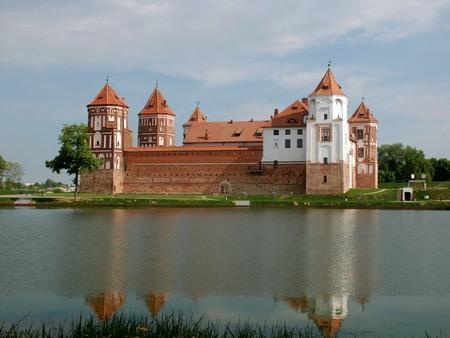
Мирский замок — резиденция магнатов Великого Литовского княжества
В белорусском посёлке Мир, на правом берегу речушки Мирянки стоит величественный Мирский замок. Впервые поселение Мир упоминается в хрониках 1395 года в связи с набегом рыцарей-крестоносцев. Целью похода было уничтожение иноверческих отрядов воинов-татар, состоявших на службе у великого князя Литовского Витовта. После нападения Витовт передал мирские земли своему брату Сигизмунду Кейстутовичу, а тот пожаловал Мир соратнику боярину Сеньке Гедыгольдовичу. В 1490 году Мир перешёл к роду князей Ильиничей. Маршалок Великого княжества Литовского Юрий Ильинич, прославившийся успехами на дипломатическом и военном поприще, заложил в мирских владениях замок. С 1522 по 1526 годы над равниной близ местечка Мир была воздвигнута резиденция-крепость в позднеготическом стиле. Наличие толстых стен с бойницами и боевых галерей свидетельствовало о хорошей обороноспособности дворца. Однако в то время посёлок Мир был относительно спокойным местом, и Юрий Ильинич строил замок исключительно из соображений престижа, намереваясь получить титул графа Священной Римской империи. Владельцы Ильиничи так и не смогли завершить замок — после смерти Юрия его сыновья умирают один за другим, не оставив наследников. И лишь младшему сыну Ильинича — Феликсу — удалось породниться с богатыми Радзивиллами, женившись на сестре Николая «Чёрного» Радзивилла, будущего канцлера великого литовского. В радзивилловскую эпоху богатству Мирского замка могли позавидовать многие короли Европы. Вдоль северной стены Радзивиллы воздвигли изящные дворцы в стиле ренессанс и окружили замок земляным валом, по углам которого поставили оборонительные бастионы. Вокруг дворца разбили итальянский сад, утопающий в зелени цитрусовых, самшитовых и кипарисовых деревьев. Как и подобало аристократам тех времён, Радзивиллы проводили жизнь в роскоши и безделье, развлекаясь охотой, стрельбой из пушек, танцами, балами и маскарадами. Близ Мирского замка благоустроили зверинец, в котором содержали диких животных и охотились на них. Один из Радзивиллов по прозвищу «Пане Коханку» («Мой дорогой») запомнился современникам своими экстравагантными выходками. Так, однажды в разгар летнего праздника Пане Коханку устроил катание на санях. Для этого он засыпал солью парк вокруг дворца и 400-метровую дорогу, ведущую от Несвижкой резиденции к костёлу. Крестьяне и не столь зажиточные шляхтичи ещё долго подбирали возле замка соль, так как в те времена она ценилась на вес золота. Стоит отметить, что с 1586 года Мирский замок обладал статусом майората, согласно которому Мир и Несвиж (в 30 км от Мира) становились единым, неделимым поместьем. Имение не могло быть поделено между наследниками и после смерти магната переходило к его старшему сыну как неотчуждаемое имущество.
Мирский замок — музейный комплекс Белоруссии. Стены замка в Мире помнят Северную войну, раздел Речи Посполитой и вторжение Наполеона в 1812 году. Мирская резиденция неоднократно разорялась и вновь отстраивалась. Своё второе рождение замок обрёл в 1891 году, когда вышедший в отставку герой русско-турецкой войны князь Николай Святополк-Мирский переехал в Мир со своей супругой Клеопатрой и 5 сыновьями. Неподалёку от замка генерал воздвиг двухэтажный дворец и спиртзавод, вырыл пруд, по берегам которого посадил сосны и ели. После смерти мужа княгиня Клеопатра повелела возвести часовню-усыпальницу. Сегодня от былой роскоши Мирского замка осталось совсем немногое. Величественный вид сооружению придаёт сочетание красных кирпичных стен и белых оштукатуренных ниш с арочными проёмами. Для визитов туристов открыты часовня-усыпальница и башни, в стенах которых разместились экспозиции, посвящённые бывшим владельцам замка. В подвале Восточного корпуса замка открыт ресторан старобелорусской кухни. Для гостей работает отель «Мирский замок» с номерами класса «люкс» и «эконом».
Легенды Мирского замка. По сей день энтузиасты тщетно ищут сокровища Радзивиллов, утраченные в эпоху наполеоновских войн. По легенде, Мирский и Несвижский замки связаны подземным проходом протяжённостью в 30 км, по которому могли свободно разъехаться две кареты. Именно здесь были спрятаны золотые слитки и фигуры 12 апостолов, отлитые в рост человека из золота и серебра. Ещё одна популярная легенда связана с именем Николая Святополк-Мирского. Когда князь вырубил яблоневый сад и выкопал на его месте Мирское озеро, к Николаю явилась незнакомка и прокляла княжеский род такими словами: «Пусть в этом пруду утонет столько людей, сколько было вырублено деревьев». Первой в озере утонула маленькая княжна Сонечка в возрасте 12 лет, а в 1898 году жертвой проклятия пал и сам Николай. Есть у Мирского замка и свои привидения — призрак Радзивилла охраняет клад, а ночью по тёмным коридорам бродит дух Софьи Святополк-Мирской. Весной княжескую усыпальницу затапливают талые воды, поэтому душа Софии никак не может обрести вечный покой.
Мірскі замак — шэдэўр беларускага дойлідства

Мірскі замак — рэзідэнцыя магнатаў Вялікага Літоўскага княства
У беларускім пасёлку Мір, на правым беразе рачулкі Мирянки варта велічны Мірскі замак. Упершыню паселішча Свет згадваецца ў хроніках 1395 у сувязі з набегам рыцараў-крыжакоў. Мэтай паходу было знішчэнне иноверческих атрадаў воінаў-татараў, якія складаліся на службе ў вялікага князя Літоўскага Вітаўта. Пасля нападу Вітаўт перадаў мірскія зямлі свайму брату Жыгімонту Кейстутавічу, а той завітаў Свет паплечніку баярыну Сянько Гедыгольдовичу. У 1490 Свет перайшоў да роду князёў Іллінічаў. Маршалак Вялікага княства Літоўскага Юрый Іллініч, які праславіўся поспехамі на дыпламатычным і ваенным ніве, заклаў у мірскіх уладаннях замак. З 1522 па 1526 гады над раўнінай каля мястэчка Мір была ўзведзена рэзідэнцыя-крэпасць у позднеготическом стылі. Наяўнасць тоўстых сцен з байніцамі і баявых галерэй сведчыла пра добрую абараназдольнасці палаца. Аднак у той час пасёлак Мір быў адносна спакойным месцам, і Юры Іллініч будаваў замак выключна з меркаванняў прэстыжу, маючы намер атрымаць тытул графа Свяшчэннай Рымскай імперыі. Уладальнікі Іллінічы так і не змаглі завяршыць замак — пасля смерці Юрыя яго сыны паміраюць адзін за адным, не пакінуўшы нашчадкаў. І толькі малодшаму сыну Ільініча — Феліксу — атрымалася парадніцца з багатымі Радзівіламі, ажаніўшыся на сястры Мікалая «Чорнага» Радзівіла, будучага канцлера вялікага літоўскага. У Радзівілаўскага эпоху багацця Мірскага замка маглі пазайздросціць многія каралі Еўропы.
Уздоўж паўночнай сцяны Радзівілы ўзвялі хупавыя палацы ў стылі рэнесанс і акружылі замак земляным валам, па баках якога паставілі абарончыя бастыёны. Вакол палаца разбілі італьянскі сад, тапелец ў зеляніне цытрусавых, самшытавымі і кіпарысавыя дрэў. Як і належала арыстакратам тых часоў, Радзівілы праводзілі жыццё ў раскошы і гультайства, забаўляючыся паляваннем, стральбой з гармат, танцамі, балямі і маскарады. Каля Мірскага замка добраўпарадкавалі звярынец, у якім ўтрымлівалі дзікіх жывёл і палявалі на іх. Адзін з Радзівілаў па мянушцы «Пане Каханку» («Мой дарагі») запомніўся сучаснікам сваімі экстравагантнымі выхадкамі. Так, аднойчы ў разгар летняга свята Пане Каханку зладзіў катанне на санях. Для гэтага ён засынаў соллю парк вакол палаца і 400-метровую дарогу, якая вяла ад Несвижкой рэзідэнцыі да касцёла. Сяляне і не гэтак заможныя шляхцічы яшчэ доўга падбіралі каля замка соль, так як у тыя часы яна шанавалася на вагу золата. Варта адзначыць, што з 1586 года Мірскі замак валодаў статусам маярату, згодна з якім Мір і Нясвіж (у 30 км ад Міра) станавіліся адзіным, непадзельным маёнткам. Маёнтак не магло быць падзелена паміж спадчыннікамі і пасля смерці магната пераходзіла да яго старэйшаму сыну як неотчуждаемое маёмасць.
Мірскі замак — музейны комплекс Беларусі. Сцены замка ў Міры памятаюць Паўночную вайну, падзел Рэчы Паспалітай і ўварванне Напалеона ў 1812 годзе. Мірская рэзідэнцыя неаднаразова вядзе да галечы і зноў адбудоўвалася. Сваё другое нараджэнне замак здабыў у 1891 годзе, калі які выйшаў у адстаўку герой руска-турэцкай вайны князь Мікалай Святаполк-Мірскі пераехаў у Мір са сваёй жонкай Клеапатрай і 5 сынамі. Непадалёк ад замка генерал падняў двухпавярховы палац і спіртзавод, выкапаў сажалку, па берагах якога пасадзіў хвоі і елкі. Пасля смерці мужа княгіня Клеапатра загадала ўзвесці капліцу-пахавальню. Сёння ад былой раскошы Мірскага замка засталося зусім няшмат. Велічны выгляд будынку надае спалучэнне чырвоных цагляных сцен і белых атынкаваных ніш з арачнымі праёмамі. Для візітаў турыстаў адкрыты капліца-пахавальня і вежы, у сценах якіх размясціліся экспазіцыі, прысвечаныя былым уладальнікам замка. У падвале Усходняга корпуса замка адкрыты рэстаран старабеларускай кухні. Для гасцей працуе гатэль «Мірскі замак» з нумарамі класа «люкс» і «эканом».
Легенды Мірскага замка. Па сённяшні дзень энтузіясты дарэмна шукаюць скарбы Радзівілаў, страчаныя ў эпоху напалеонаўскіх войнаў. Паводле легенды, Мірскі і Нясвіжскі замкі звязаны падземным праходам працягласцю ў 30 км, па якім маглі вольна раз’ехацца 2 карэты. Менавіта тут былі схаваныя залатыя зліткі і фігуры 12 апосталаў, адлітыя ў рост чалавека з золата і срэбра. Яшчэ адна папулярная легенда звязана з імем Мікалая Святаполк-Мірскага. Калі князь высек яблыневы сад і выкапаў на яго месцы Мірскае возера, да Мікалая з’явілася незнаёмка і пракляла княскі род такімі словамі: «Хай у гэтым сажалцы патоне столькі людзей, колькі было высечана дрэў». Першай у возеры патанула маленькая князёўна Сонечка ва ўзросце 12 гадоў, а ў 1898 годзе ахвярай праклёны упаў і сам Мікалай. Ёсць у Мірскага замка і свае прывіды — прывід Радзівіла ахоўвае скарб, а ноччу па цёмных калідорах блукае дух Соф’і Святаполк-Мірскай. Увесну княжацкую пахавальню падпальваюць адталыя вады, таму і душа Сафіі ніяк не можа здабыць вечны спакой.
Mir Castle — a masterpiece of the Belarusian architecture
M
The Belarusian village of Peace, on the right bank of river laywoman stands the majestic Castle of Mir. World first settlement mentioned in the chronicles in 1395 in connection with the raid of knights. The aim of the campaign was the destruction of heterodox groups of soldiers-Tatars in the service of the Grand Duke of Lithuania Vytautas. After the attack, Vytautas gave worldly land to his brother Sigismund Keystutovichu, who granted the World colleague boyar Senka Gedygoldovichu. In 1490, world has moved to the genus Ilinich princes. Marshal of the Grand Duchy of Lithuania Yuri Ilinich, famous for success in the diplomatic and military career, laid in worldly possessions lock. From 1522 to 1526 years, the plain near the town of Mir was built residence-fortress in late Gothic style. The presence of thick walls with loopholes and combat galleries indicative of a good defense of the palace. However, while the town was relatively quiet world of the place, and Yuri Ilinich castle built solely for reasons of prestige, intending to get the title of Count of the Holy Roman Empire. Ilinich owners have not been able to complete the castle — after the death of George, his sons die one by one, leaving no heirs. Only the youngest son Ilinich — Felix — were able to intermarry with the wealthy Radziwill, married to the sister of Nicholas «Black» Radziwill, the future Chancellor of the Lithuanian. In the era of wealth Radziwill Mir Castle could envy of many kings of Europe. Along the north wall Radziwill graceful palaces erected in the Renaissance style castle and surrounded the earthen wall, the corners of which have put defensive bastions. Around the palace smashed Italian garden, surrounded by green citrus, boxwood and cypress trees. As befits the aristocrats of the time, the Radziwills spent a life of luxury and idleness, having fun hunting, shooting guns, dances, balls and masquerades. Near Mir Castle landscaped zoo, which contained the wild animals and hunting them. One of the Radziwill, nicknamed «Pane Kohanku» («My Dear») contemporaries remembered for his extravagant antics. So, one day in the midst of a summer holiday Pan Kohanku arranged sledding. For this, he fell asleep with salt park around the palace and the 400-meter road from Nesvizhkoy residence to the church. Farmers and less affluent gentry long picking near the Castle salt, because in those days it was worth its weight in gold. It should be noted that since 1586 the Mir Castle had the status of primogeniture, under which peace and Shults (30 km from the world) became a single, undivided estate. The estate is not to be divided among the heirs after the death of tycoon passed to his eldest son as the inalienable property.
Mir Castle — Museum, Belarus. The walls of the castle in the world remember the Great Northern War, the section of Poland and the invasion of Napoleon in 1812. Worldly residence repeatedly ruined and rebuilt again. A renaissance castle found in 1891, when a retired hero of the Russian-Turkish war of Prince Nicholas Svyatopolk-Mirsky moved into the world with his wife, Cleopatra and 5 sons. Not far from the castle erected general two-storey palace and distillery, dug a pond, on the banks of which planted pine and spruce. After her husband died, Princess Cleopatra ordered to build the chapel crypt. Today from the former luxury Mir Castle remains very much. Majestic views of the construction gives a combination of red brick walls and white plaster niches with arched openings. Tourist visits to open the tomb and chapel-tower, in which the walls of an exhibition dedicated to the former owners of the castle. In the basement of the East of the lock is a restaurant old Belarusian cuisine. Guests running hotel «Mir Castle» with the numbers of class «luxury» and «economy».
Legends of Mir Castle. To this day, enthusiasts desperately seek Radziwill treasures lost during the Napoleonic wars. According to legend, Mir and Nesvizh locks connected underground passage length of 30 km, which were free to disperse two coaches. It is here that were hidden gold bullion and 12 apostles cast a man’s height of gold and silver. Another popular legend associated with the name Nicholas Svyatopolk-Mirsky. When Prince knocked an apple orchard and dug in his place Worldly lake to Nicholas was a stranger and cursed princely family, saying: «Let this pond will sink as many people as trees were cut down.» First drowned in the lake little Princess Sonia, aged 12 years, and in 1898 fell victim to the curse and Nicholas himself. There is at the Mir Castle and its ghosts — ghost Radziwill guards the treasure, and at night the dark corridors of the spirit haunting Sophia Svyatopolk-Mirsky. Spring prince’s tomb flooded with melt water, so Sophia soul can not find eternal peace.
Mir Castle — ein Meisterwerk der belarussischen Architektur
M
Die weißrussische Dorf des Friedens, auf dem rechten Ufer des Flusses Laienfrau steht das majestätische Schloss von Mir. Weltweit erste Siedlung in den Chroniken 1395 im Zusammenhang mit dem Überfall der Ritter genannt. Das Ziel der Kampagne war die Zerstörung der heterodoxen Gruppen von Soldaten-Tataren in den Dienst der Großfürst von Litauen Vytautas. Nach dem Angriff gab Vytautas weltlichen Land zu seinem Bruder Sigismund Keystutovichu, die die Welt Kollegin Bojaren Senka Gedygoldovichu gewährt. In 1490, hat weltweit zu der Gattung Ilinich Fürsten verschoben. Marschall des Großherzogtums Litauen Yuri Ilinich, berühmt für den Erfolg in der diplomatischen und militärischen Karriere, in weltlichen Besitz gelegt sperren. Von 1522 bis 1526 Jahren wurde die Ebene in der Nähe der Stadt Mir Residenz-Festung im spätgotischen Stil erbaut. Das Vorhandensein von dicken Mauern mit Schießscharten und Kampf Galerien Hinweis auf eine gute Verteidigung des Palastes. Doch während die Stadt relativ ruhige Welt des Ortes war, und Yuri Ilinich Burg gebaut ausschließlich aus Gründen des Prestiges, die beabsichtigen, den Titel eines Grafen des Heiligen Römischen Reiches erhalten. Ilinich Besitzer haben es nicht gelungen, die Burg komplett — nach dem Tod von George, sterben die Söhne eins nach dem anderen, so dass keine Erben. Nur der jüngste Sohn Ilinich — Felix — konnten mit dem wohlhabenden Radziwill, verheiratet mit der Schwester von Nicholas «Black» Radziwill, die Zukunft Kanzler der litauischen heiraten. In der Ära des Wohlstands Radziwill Schloss Mir konnte von vielen Königen von Europa beneiden. Entlang der nördlichen Wand Radziwill anmutigen Paläste errichtet im Stil der Renaissance Schloss und umgeben den Erdwall, dessen Ecken Verteidigungsbastionen gesetzt haben. Rund um den Palast zerschlagen italienischen Garten, umgeben von grünen Zitrusfrüchten, Buchsbaum und Zypressen umgeben. Wie es sich für die Aristokraten der Zeit verbrachten die Radziwills ein Leben in Luxus und Müßiggang, Spaß Jagd, schießen Pistolen, Tänze, Bälle und Maskeraden. Nahe Schloss Mir angelegten Zoo, enthalten, die die wilden Tiere und die Jagd nach ihnen. Einer der Radziwill, der den Spitznamen «Pane Kohanku» («My Dear») Zeitgenossen erinnern für seine extravaganten Possen. Also, eines Tages in der Mitte einen Sommerurlaub Pan Kohanku angeordnet Rodeln. Dafür schlief er mit Salz Park rund um das Schloss und den 400-Meter-Straße von Nesvizhkoy Wohnsitz in der Kirche. Landwirte und weniger wohlhabenden Adels langen Kommissionierung der Nähe der Burg Salz, weil in jenen Tagen war es wert sein Gewicht in Gold. Es wird darauf hingewiesen, dass seit 1586 die Mir Castle den Status der Erstgeburt hatte, unter denen Frieden und Shults (30 km von der Welt) eine einzige, ungeteilte estate geworden sein. Das Anwesen befindet sich nicht unter den Erben nach dem Tod des tycoon weitergegeben an seinen ältesten Sohn als unveräußerliches Eigentum aufgeteilt werden.
Mir Castle — Museum, Belarus. Die Wände des Schlosses in der Welt erinnern, den Großen Nordischen Krieg, den Abschnitt von Polen und die Invasion Napoleons im Jahr 1812. Weltliche Residenz mehrmals zerstört und wieder aufgebaut. Ein Renaissance-Schloss im Jahr 1891 gefunden, als ein pensionierter Held des Russisch-Türkischen Krieges von Fürst Nikolaus Swjatopolk-Mirsky in die Welt zog mit seiner Frau, Cleopatra und 5 Söhne. Nicht weit von der Burg errichteten allgemeinen zweistöckigen Palast und Brennerei, gruben einen Teich, an den Ufern von denen Kiefern und Fichten gepflanzt. Nach dem Tod ihres Mannes, befahl Prinzessin Cleopatra, die Kapelle Krypta bauen. Heute aus der ehemaligen Luxus-Schloss Mir bleibt sehr viel. Majestic Blick auf die Konstruktion gibt eine Kombination aus roten Backsteinmauern und weißem Putz Nischen mit gewölbten Öffnungen. Tourist besucht das Grab und Kapelle-Turm zu öffnen, in denen die Wände einer Ausstellung an die ehemaligen Eigentümer des Schlosses gewidmet. Im Untergeschoss des Ostens des Schlosses befindet sich ein Restaurant alten belarussischen Küche. Guests Hotel «Mir Castle» mit den Zahlen der Klasse «Luxus» und «Wirtschaft».
Legends of Mir Castle. Bis zum heutigen Tag, Enthusiasten verzweifelt suchen Radziwill Schätze während der Napoleonischen Kriege verloren. Nach der Legende, sperrt Mir und Nesvizh verbunden unterirdischen Gang Länge von 30 km, die frei auf zwei Busse verteilen waren. Es ist hier, dass waren Goldbarren versteckt und 12 Apostel gegossen eines Mannes Höhe von Gold und Silber. Eine andere beliebte Legende mit dem Namen Nicholas Swjatopolk-Mirsky verbunden. Als Prinz eine Apfelplantage klopfte und grub an seiner Stelle Worldly See Nicholas war ein Fremder und verflucht fürstlichen Familie und sagte: «. Lassen Sie diese Teich so viele Menschen sinken wie Bäume wurden abgeholzt» Zuerst in den See kleine Prinzessin Sonia, ab 12 Jahren ertrunken, und im Jahre 1898 zum Opfer fiel dem Fluch und Nicholas sich. Es ist an der Mir Schloss und seine Geister — ghost Radziwill bewacht den Schatz, und in der Nacht die dunklen Korridore des Geistes spukt Sophia Swjatopolk-Mirsky. Frühling Prinzen Grab überschwemmt mit Schmelzwasser, so Sophia S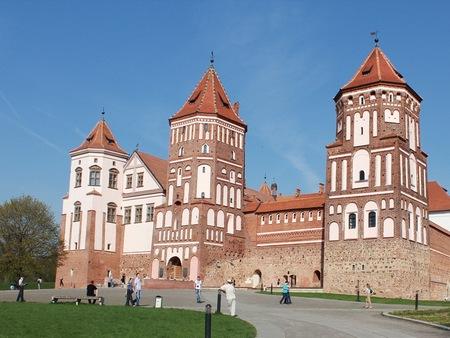
Mir castle included in the list of the most popular sights of Belarus. To visit this place is included in the plan of any guidebook for our country. A lot of mystical mysteries and legends have created an attractive aura and an attractive atmosphere to this place. This article has collected photos, useful information, history, as well as videos and a list of excursions.
Mir Castle how to get from Minsk
Distance from center Minsk to the urban village of Mir — 97,6 kilometer. By car, the journey will take approximately 1,5 hours. It is optimal to go along the M1 highway to the sign for the “Mir Castle” exit, so you will get to the regional road P64. There will be no difficulties, there are enough landmarks to the castle along the way.
You can also take a bus from the central station. The first departs early in the morning at 6:40, the last at 18:10. The ticket price is about 6 rubles.
About Mir Castle
Mir castle began its history at the beginning of the 16th century and is rightfully considered an excellent example of a defensive and fortified complex middle ages. The walls of the original building were about 13 meters high and about 3 meters thick at the base.
Worthy of special attention Mir castle towers, which are decorated with numerous niches and ornamental belts.
Today, only the southwestern, entrance and main towers have retained their original Gothic features. Other parts of the castle complex received the forms and decor of Renaissance architecture.
Mir castle included in the UNESCO cultural heritage list. It belonged to many famous families who contributed to the political and cultural development of this place and Belarus as a whole. Among them Ilinichi, Radziwills, Wittgensteins and Svyatopolk-Mirskys.
All the owners of the castle treated it with care, trying to keep it in the best possible condition, improve it and add new elements and buildings.
Each war left behind devastation in these places, starting from the Great Northern War.
Mir Castle many times it was destroyed, so it was in the late 90s, but in 2010 the castle was completely restored.
Today, Mir Castle of the Ilyinichs and the Radziwills is a cultural heritage site with a well-developed infrastructure.
Thousands of tourists come here every year and this place can be called the most popular attraction in the country. Like many medieval castles, Mir Castle Complex associated with many legends that the locals love to tell.
Legend of the Mir Castle
For example, one of the legends is associated with a stone located in one of the walls on the south side of the castle. Outwardly, it resembles the head of a ram. There is a saying that if you get this stone, then the entire castle in the World will collapse and the land on which it is located will become desolated. It is believed that this “head” is a talisman that protected the building from ill-wishers and enemies.
Still wandering around this castle ghosts, and treasure hunters are still trying to find a secret underground passage between Mirsky and Nesvizh castle. There is an opinion that full-length sculptures of the twelve apostles made of gold and silver are hidden in it.
People are still afraid to approach the cursed Mirskoye Lake, on the site of which there used to be a flowering garden. It is believed that the lake was cursed by a stranger: “Let as many people drown in this pond as there were trees cut down”. Since then, its water has taken many lives.
Mir Castle tour options
Excellent local and Minsk guides will be happy to conduct individual and group tours for you. List with prices below:
Remember that the World is not only the heritage of the Ilyinichs and the Radziwills. In the urban village you can still see bosom и церковь.
In addition, dozens of worthy sights of Belarus. What is it worth church in Ishkoldi и Radziwill’s estate in Polonechka.
| UNESCO World Heritage Site | |
|---|---|
 |
|
| Location | Mir, Belarus |
| Criteria | Cultural: ii, iv |
| Reference | 625 |
| Inscription | 2000 (24th Session) |
| Area | 27 ha |
| Website | mirzamak.by/en/ |
| Coordinates | 53°27′4.46″N 26°28′22.80″E / 53.4512389°N 26.4730000°ECoordinates: 53°27′4.46″N 26°28′22.80″E / 53.4512389°N 26.4730000°E |
|
Location of Mir Castle Complex in Belarus |
The Mir Castle Complex (Belarusian: Мірскі замак, romanized: Mirski zamak, Russian: Мирский замок) is historic fortified castle and a UNESCO World Heritage Site in Belarus.[1] It is located in the town of Mir, in the Kareličy District of Hrodna Voblaść, at 53°27′4.46″N 26°28′22.80″E / 53.4512389°N 26.4730000°E, 29 kilometres (18 mi) north-west of another World Heritage site, Niaśviž Castle. Mir Castle Complex is 164 metres (538 ft) above sea level.[2] Erected in the 16th century in the late Brick Gothic style, it is one of the few remaining architectural monuments of the former Polish–Lithuanian Commonwealth in contemporary Belarus.
History[edit]
Duke Juryj Ivanavič Illinič (pl:Jerzy Iwanowicz Ilinicz) began construction of the castle near the village of Mir after the turn of the 16th century in the Belarusian Gothic style. Five towers surrounded the courtyard of the citadel, the walls of which formed a square of 75 metres (246 ft) on each side. In 1568, when the Ilyinich dynasty died out, the Mir Castle passed into the hands of Mikalaj Kryštafor «the Orphan» Radziwil, who refitted it with a two-winged, three-story stately residence along the eastern and northern inner walls of the castle. Plastered facades were decorated with limestone portals, plates, balconies and porches in the Renaissance style.
In 1817, after the castle had been abandoned for nearly a century and had suffered severe damage in the Battle of Mir (1812), owner Daminik Hieranim Radziwil died of battle injuries and the castle passed to his daughter Stefania, who married Ludwig zu Sayn-Wittgenstein-Berleburg. Later the castle became a possession of their daughter Maria, who married Prince Chlodwig Hohenlohe-Schillingsfürst.
Their son, Maurice Hohenlohe-Schillingsfürst, sold the castle to Mikalaj Sviatapolk-Mirski, of the Bialynia clan, in 1895. Mikalaj’s son Michail began to rebuild the castle according to the plans of architect Teodor Bursche. The Sviatapolk-Mirski family owned the castle until 1939, when the Soviet Union occupied Western Belarus.
When German forces invaded the Soviet Union in 1941, they occupied the castle and converted it to a ghetto for the local Jewish population, prior to their murders. Between 1944 and 1956, the castle was used as a housing facility, resulting in damage to the castle’s interior.
In December 2000, the Mir Castle was listed by UNESCO as a World Heritage Site.[3]
[edit]
- Niaśviž Castle
- Litomyšl Castle
Gallery[edit]
References[edit]
- ^ «21 World Heritage Sites you have probably never heard of». The Telegraph. Daily Telegraph. 4 February 2016.
- ^ «Cyrvonaarmiejskaja Vulica Mir Belarus on the Elevation Map. Topographic Map of Cyrvonaarmiejskaja Vulica Mir Belarus».
- ^ «Landmarks, historic and cultural, and natural sites of the Republic of Belarus on the UNESCO World Heritage List». Land of Ancestors. National Statistical Committee of the Republic of Belarus. 2011. Archived from the original on 10 June 2016. Retrieved 12 October 2013.
External links[edit]
- Mir Castle Official Website
- Mir Castle on official website of the Republic of Belarus
- Castle in Mir
- Official UNESCO site
- The Mir Castle
- Photos on Radzima.org
- Jurkau kutoczak — Юркаў куточак — Yury’s Corner. Старажытнае дойлідства Міра
- Photos on Globus.tut.by
- Mir Castle on 3D F4 Map
History
Mir Castle Complex of XVI–XX centuries in a small town Mir is a historical and cultural value of national importance and UNESCO World Heritage.
For the first time Мir was mentioned in 1434 when it becomes a private estate of Senko Gedygoldovich. According to his will in 1451 Mir passes to Anna Butrimovna, his foster daughter. In 1476 Anna gives Mir as possession for life to Senko’s wife Milokhna, and after her death – to her cousin Yury Ilinich, who started building the castle.
Mir surroundings on the map of T. Makovskiy; edition of 1613, Amsterdam
The owner of Mir had stronr reasons for erecting such a mighty fortification building. At the beginning of the 16th century Crimean Tatars attacked these lands more frequently. Unstable political situation was worsened by the hostility among the feudal groups inside the country.
In particular, the Iliniches were in confrontation with a very powerful and influential prince Mikhail Glinsky. Nevertheless there was one more important reason for building the castle. Yury Ilinich aspired to get a title of a count of the Holy Roman Empire and one of the necessary conditions for this was having a stone castle. This was the first case when such a mighty fortress was built on the territory of the Grand Duchy of Lithuania by a private owner.
At the first stage of construction five towers were erected. They were connected with walls whose thickness at the foundation was up to three meters. All the towers were planned as independent centers of resistance. They were erected in such a way that it was convenient to deliver flanking fire along the walls and to hit an approaching target. Each tower was about 25 meters in height and had five fighting storeys with loopholes and a complex system of inner passages. The builders used three-layer laying – the inner and outer parts of the walls were made of brick and huge stones and the space between them was filled with small stones and broken bricks.
Although all the towers may seem to have the same construction, each of them has its own architectural peculiarities. The lower tetrahedral part of the towers becomes octahedral at different heights slightly losing in its size. The decoration of the towers’ fronts also varies.
The owners of the castle – the Iliniches – didn’t manage to accomplish the construction. Their family died away within forty years. Shortly before his decease Yury Ilinich Junior, the grandson of the founder, bequeathed Mir County to his cousin Prince Mikolaj Krzysztof Radziwill nicknamed the Orphan. Over the next three centuries the castle was owned by the representatives of a powerful dynasty of the Radziwills.
Having acquired the ownership rights for Mir County in 1569, Prince Mikolaj Krzysztof Radziwill nicknamed the Orphan decided to make the castle one of his residences. At his behest three-storey living palaces were erected along the northern and eastern walls of the castle, the three adjacent towers were rebuilt and a barbican at the Entrance tower appeared. Earth mounds with bastions at the angles were raised around the castle. A fosse filled with water was dug behind the earth mounds.
Mikolay Krzysztof Radziwill nicknamed the Orphan
At the end of the 16th century the bastion fortifications lost their importance. The reasons why Mikolaj Krzysztof Radziwill decided to stop further modernization of Mir Castle are still unknown. After the construction of a mighty castle in Nesvizh at the end of the 16th – beginning of the 17th centuries the princely residence moved there. Mir Castle became something like a country seat. The walls of the palace and towers were plastered and painted pink. The window and door portals were made from grey sandstone imported from Galicia. The basement and the ground floor of the palace incorporated housekeeping facilities and storerooms; the administration of Mir County, a municipal court and a clerical office were located on the first floor, the second floor was intended for the owners whose living accommodation was situated there.
At the beginning of the 17th century an Italian garden was laid out near the castle.
Mir castle. Painting of K. Rysetskiy, the middle of 19th century
After these massive transformations the castle had seen a peaceful lifetime which was broken off by a war between the Polish-Lithuanian Commonwealth and the Tsardom of Muscovy. In 1655 Mir Castle was ravaged by Cossacks of Ivan Zolotorenro and Russian troops of voivode Aleksey Trubetskoy.
The castle fell into oblivion for around 30 years. And it wasn’t until 1680 that Katarzyna (Ekaterina) Radziwill from the Sobiesky family initiated restoration works in Mir Castle after her husband Mikhail Kazimierz had died. But the Great Northern War of 1700–1721 suspended her undertakings for many years. In April 1706 Mir was invaded by the troops of Charles XII. The whole township with the castle was on fire, everything that had been restored was destroyed.
The castle regained its former grandeur thanks to a new owner – Prince Mikhail Kazimierz Radziwill nicknamed the Rybonka. The chambers of the fourth princely floor were replanned. The rooms of a similar layout, predominantly of a square type, were replaced by a suite of halls of different sizes. For this purpose the internal partitions were rearranged, the stairs line was changed. The Stateroom as well as the Portrait and Dance Halls were decorated with oak parquet floors, gilded ceilings, superb furniture, tapestry, paintings, chinaware and delftware. A lot of valuable and refined objects were produced at the Radziwills’ manufactories.
One of the Rybonka’s sons, Prince Karol Stanislaw Radziwill nicknamed Panie Kochanku, lived in Mir Castle from 1754 to 1762. He used to hold luxurious balls in the castle and invite guests for hunting. After his death in 1790 the estate was inherited by his nephew, Prince Dominik Hieronim Radziwll, who during the war of 1812 took the side of Napoleon. Lethally injured in a battle, Dominik died in 1813. His estates were divided into two parts by the emperor’s order of March 17, 1814. One part together with Mir and Nesvizh passed to Dominik’s second cousin, Prince Antony Radziwill, the other part was given to Dominik’s daughter Stefania. In 1828 she married the tsar’s adjutant Count Ludwig Wittgenstein. The ongoing legal proceedings between them and Antony Radziwill concerning the ownership of Mir County came to an end only in the 1840s. According to the decision of a special commission Mir County passed to Ludwig Wittgenstein who lived in Germany at that time. But his descendants didn’t manage to possess the castle for a long period of time. According to the Russian law adopted in 1887, foreigners (and such were the Wittgensteins, including their daughter Maria Hohenlohe-Schillingsfurst) had no right to possess property on the territory of the Russian Empire, therefore they had to sell it.
Mir Castle. Napoleon Orda, 1860–1870s
In 1891 Mir estate and the castle were purchased by a Cossack chieftain of the Don Troops, Prince Nikolay Svyatopolk-Mirsky. Apparently, the prince was attracted by the name of the estate. When he came to Mir he immediately got down to work with great enthusiasm. An alcohol plant and a two-storey palace, which became the main composition center of the palatial and park complex, were built opposite the castle. A water reservoir with islands was made in front of the new palace instead of five ponds and a cut down garden.
In 1922 Nikolay’s son Mikhail started to restore Mir Castle. The works had lasted for 16 years. During this period a part of the Eastern palace and two southern towers were restored.
Mikhail Svyatopolk-Mirsky lived in the castle till 1938.
The view of the castle from the side of the lake. 1920s
During the Great Patriotic War from May to August 1942 the castle served as a ghetto where Hitler’s forces imprisoned around 800 local Jews. In summer the prisoners organized a resistance group. On August 9, 1942 over 250 Jews managed to escape. Three days later those who stayed in ghetto were shot by fascists in the forest not far from Mir.
The column of German motor vehicles. 1941
After the liberation of Belarus in July 1944 dwellers of Mir whose houses had been ruined found refuge in the castle. The last family moved out from the castle in 1962.
The restoration works in Mir Castle began only in 1983. In 2000 it was listed by UNESCO as a World Heritage Site. On December 16, 2010 an official opening of Mir Castle took place.
The modern view of the castle

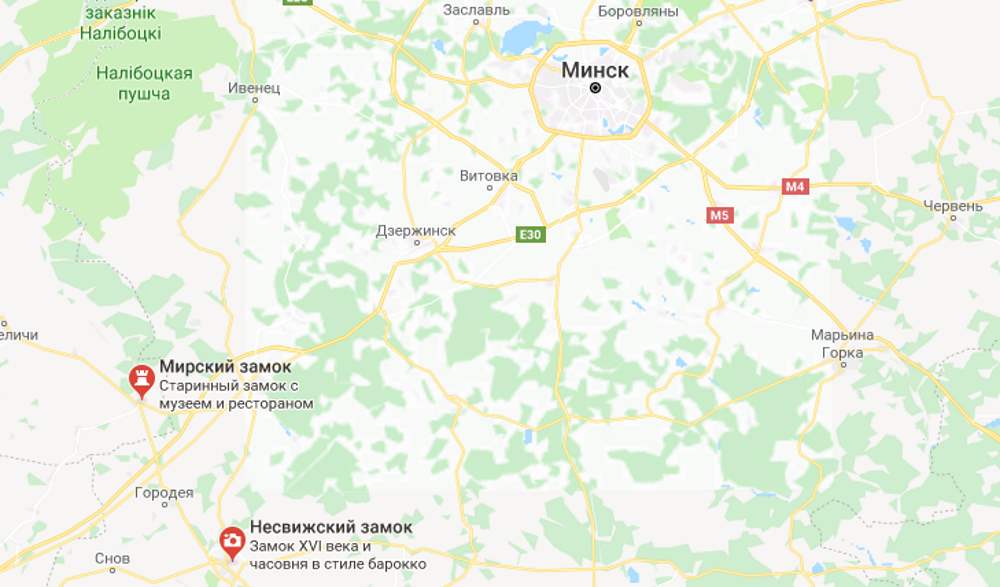

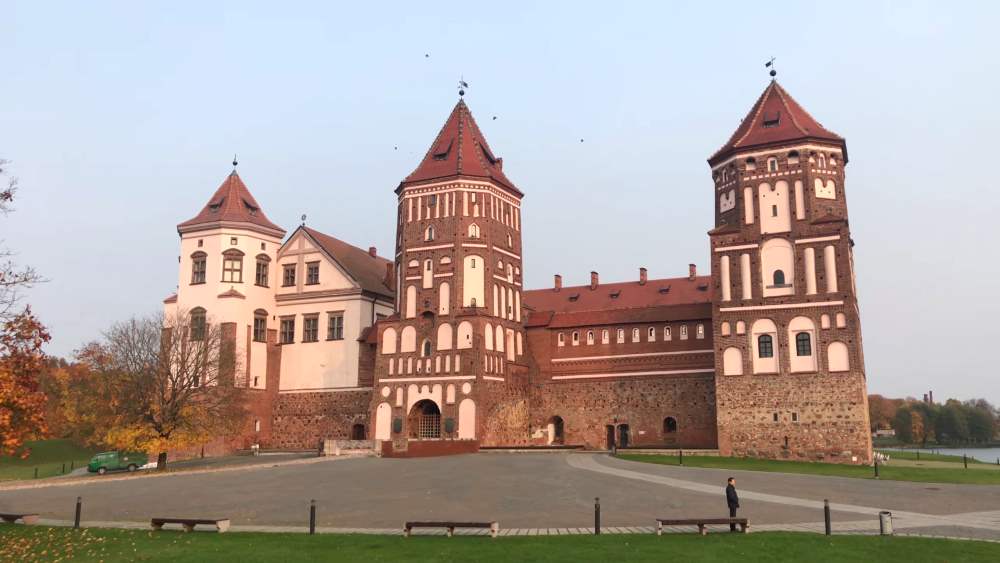
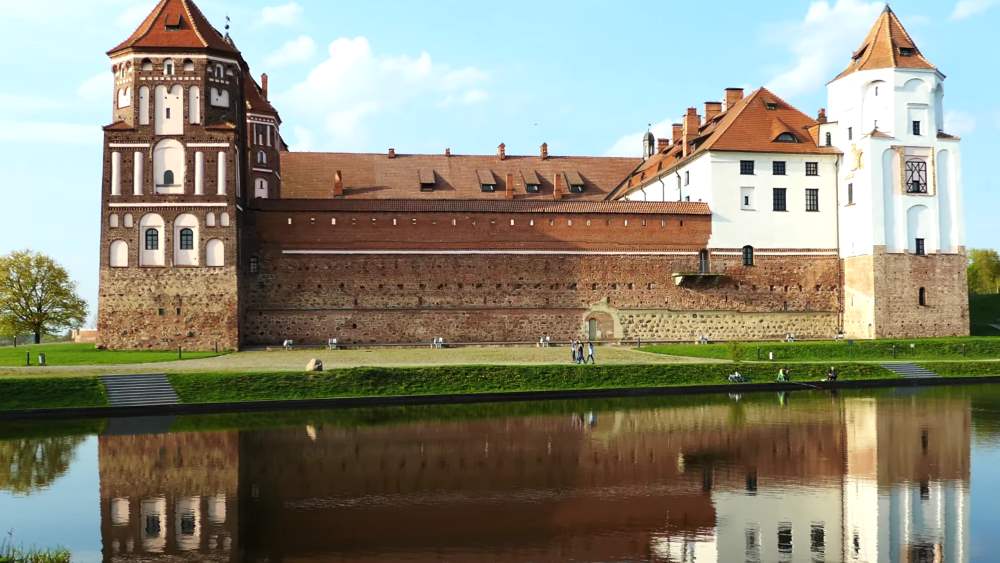
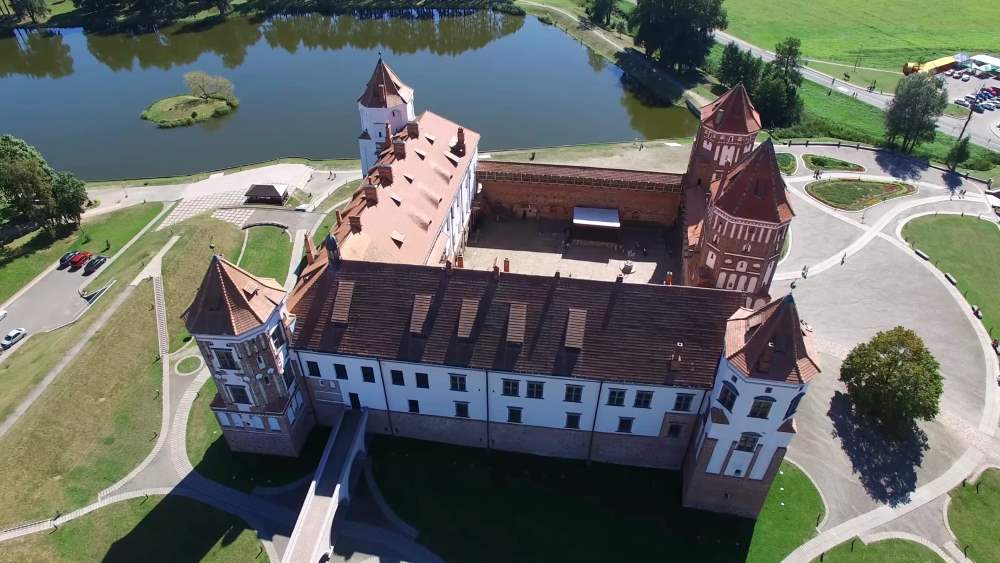
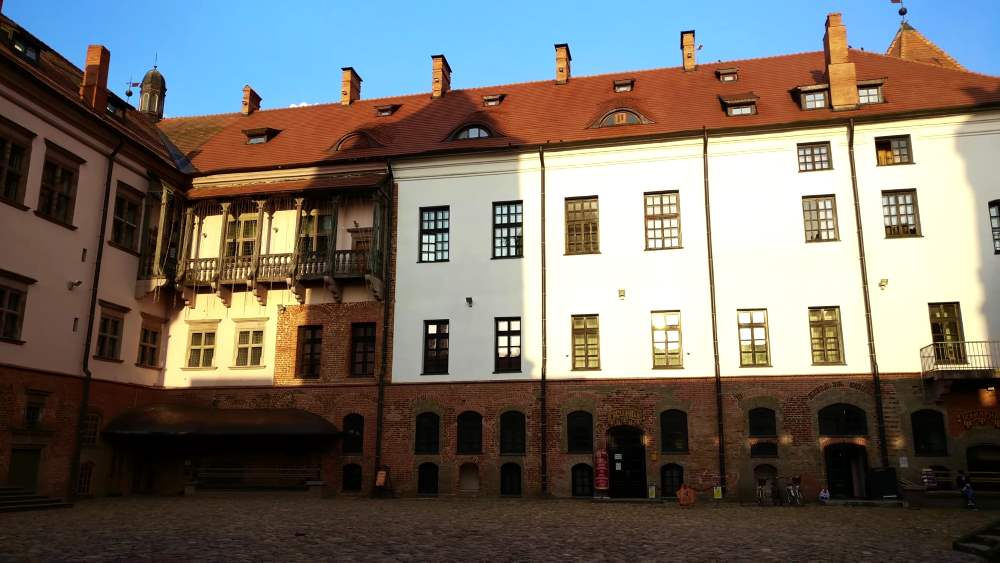
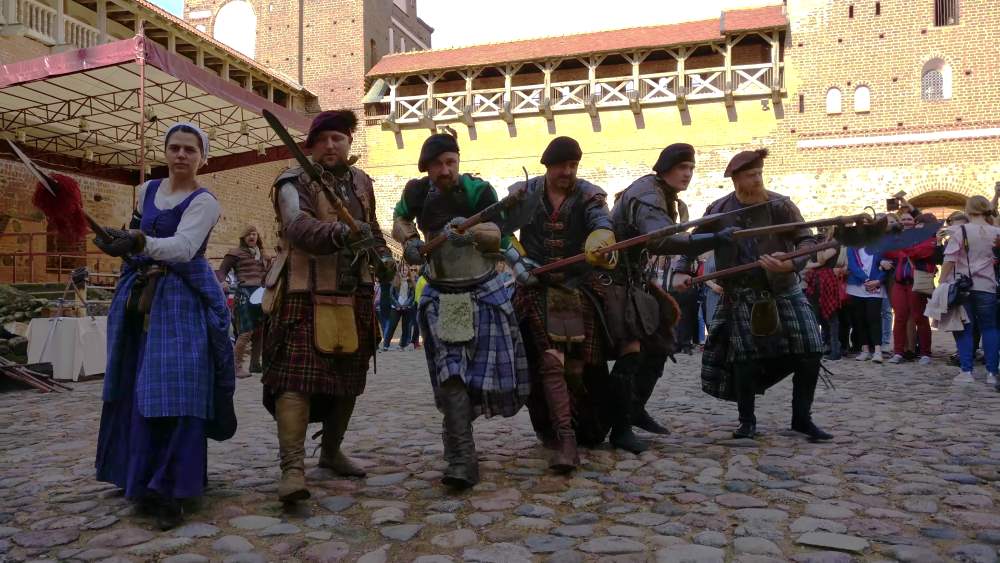
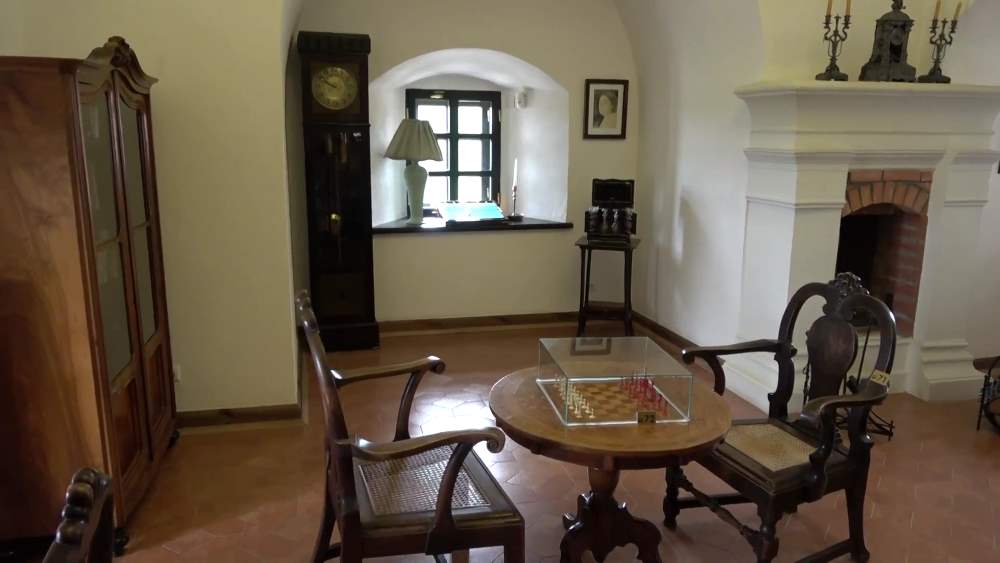
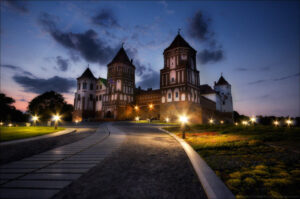
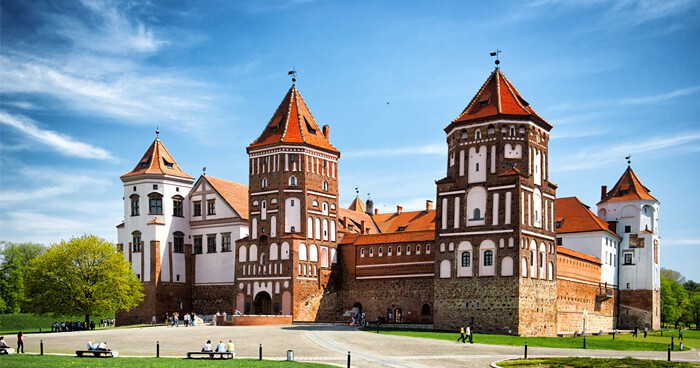
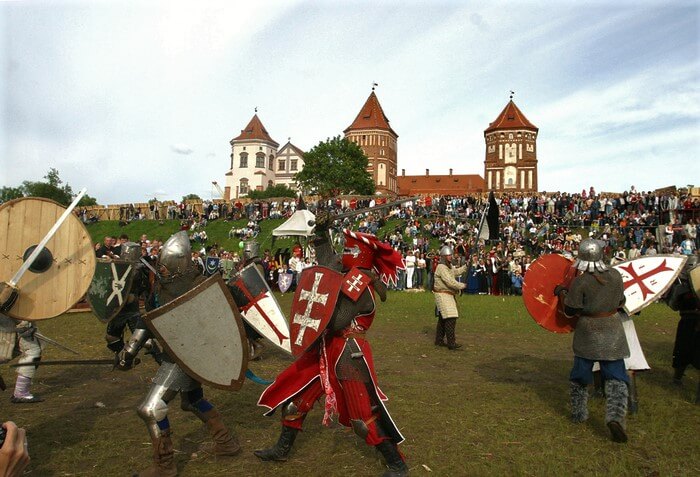
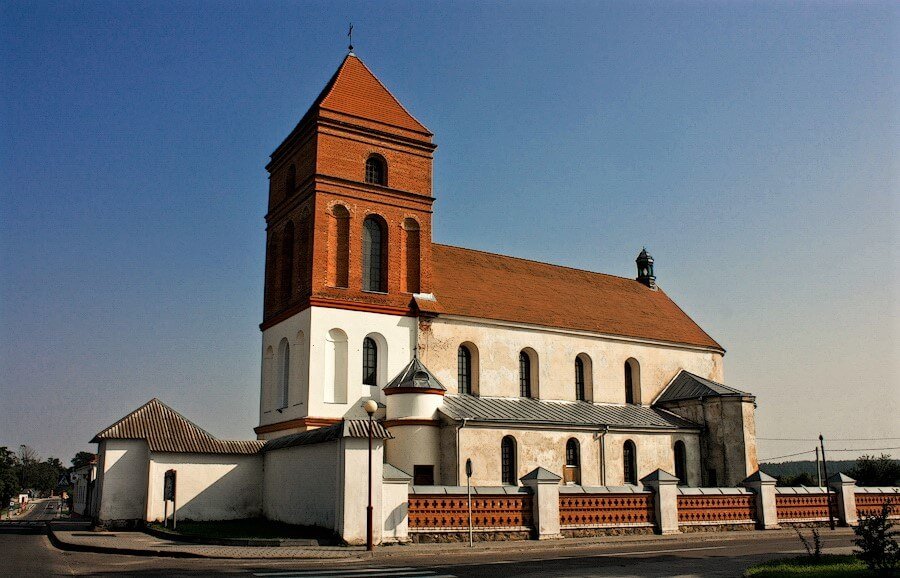
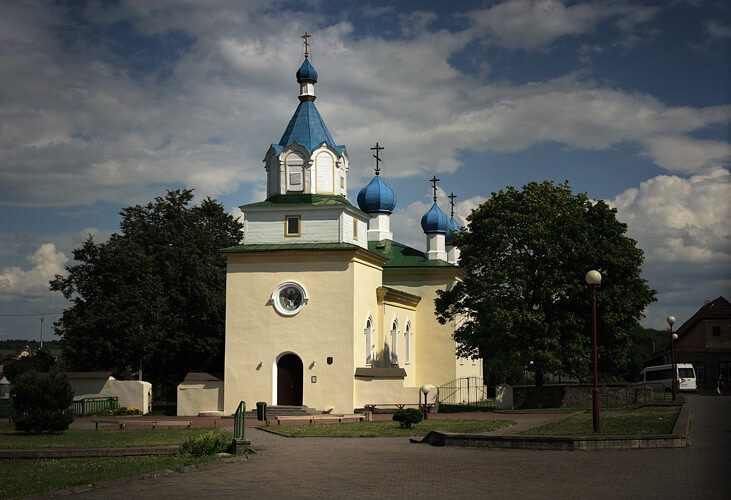
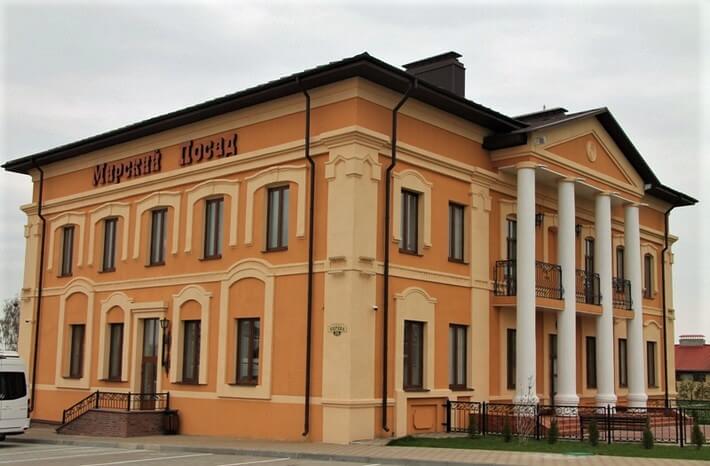

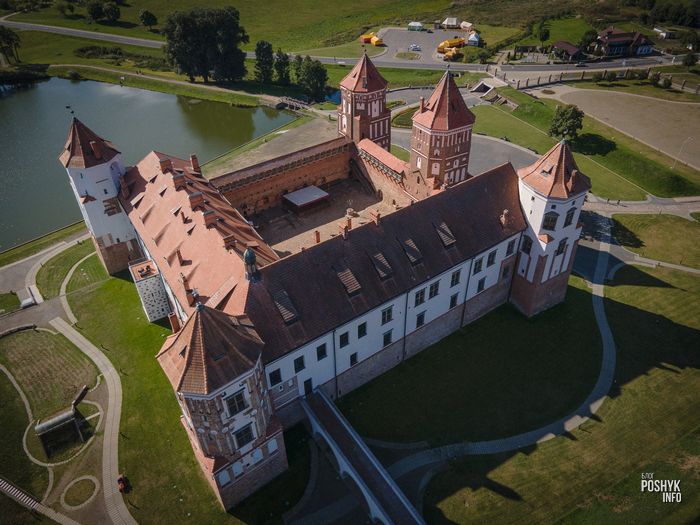
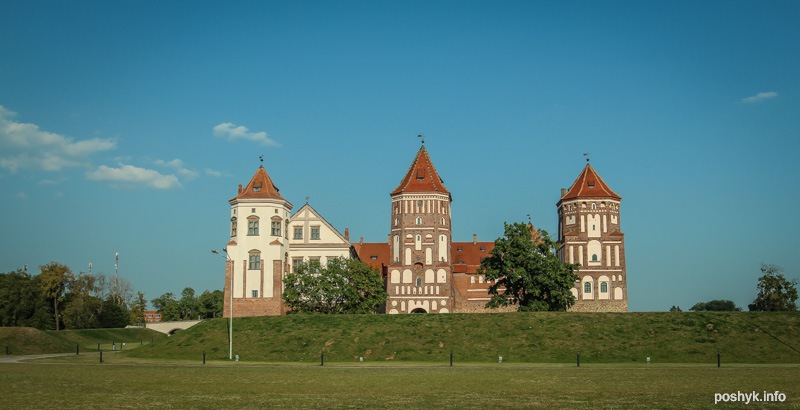


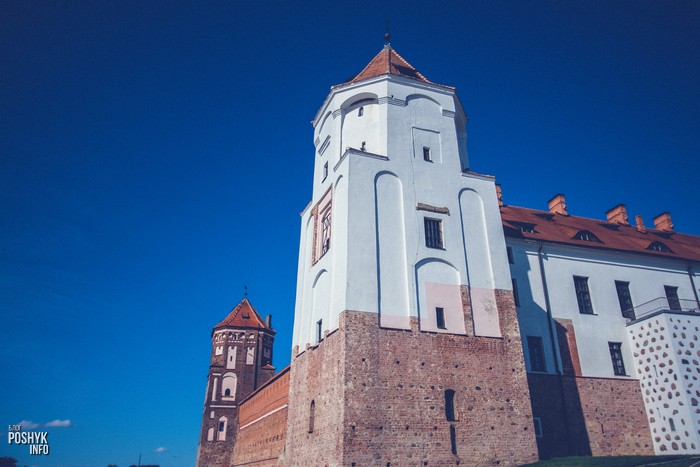

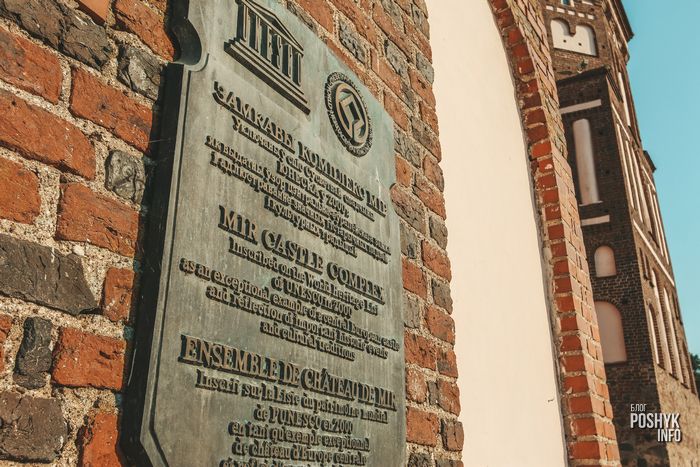

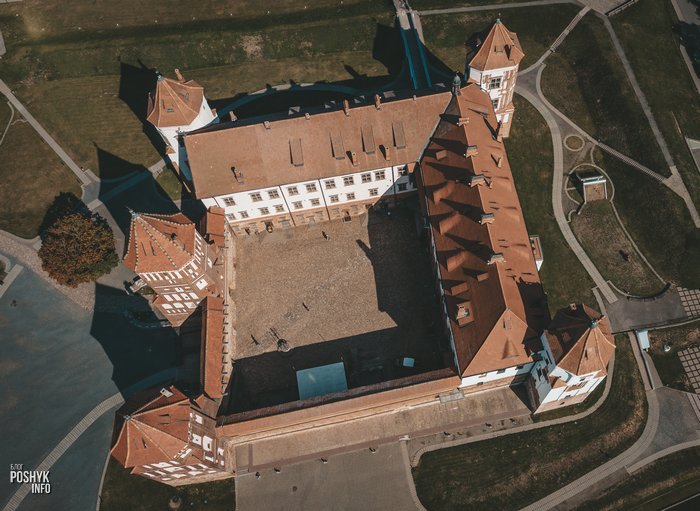



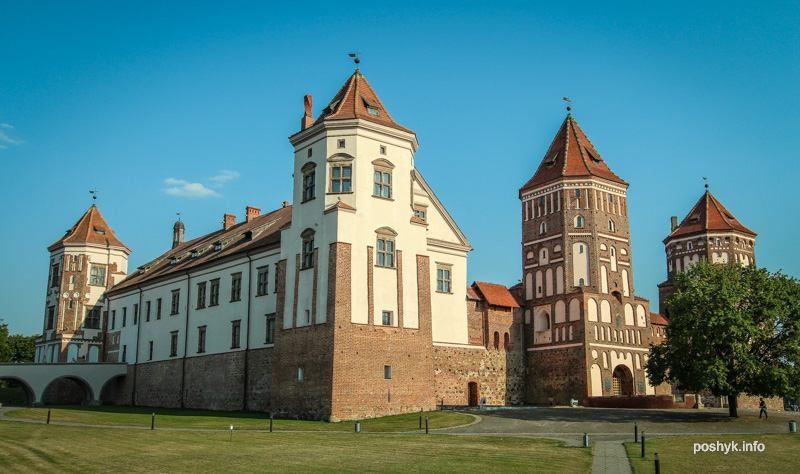











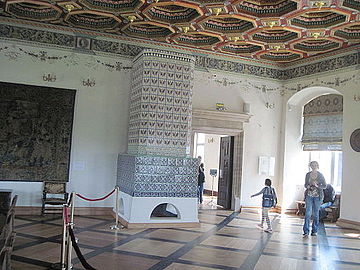



.jpg)





